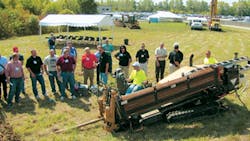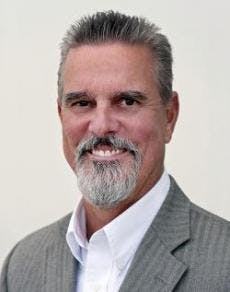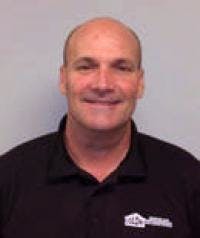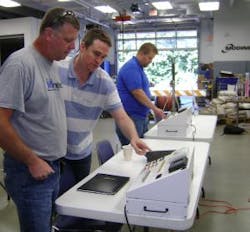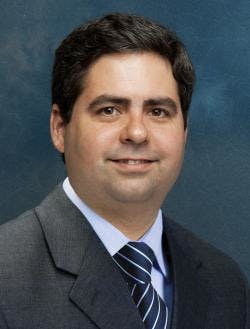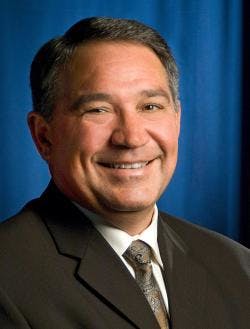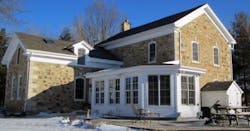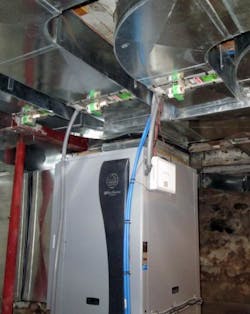Geothermal Loops Back Around
Geothermal Groundswell
by Elaine Yetzer Simon
Following a recession and some legislative hiccups, the geothermal industry is back in growth mode.
Acording to Doug Dougherty, CEO of the Geothermal Exchange Organization, 2014 was a very good year for geothermal growth, despite the significant decline caused by the extreme cold weather (aka the “polar vortex”). He expects the same strong performance during 2015.
“Once the weather broke, we had a resurgence of adoption of the technology in homes and we made up, and then some, all of what we lost in the first quarter,” he said. “We anticipate a very good 2015 in terms of residential shipments.”
Dougherty says the number of commercial installations are also increasing.
“We’ve seen an uptick in architects and mechanical engineers understanding the economic benefits of putting in a geothermal heat pump in a commercial building,” he said. “We have real, quantitative data that shows that commercial buildings that put in geothermal heat pumps have a payback of less than two years versus a conventional HVAC system.”
We have real, quantitative data that shows that commercial buildings that put in geothermal heat pumps have a payback of less than two years versus a conventional HVAC system.”
— Doug Dougherty
The biggest drivers of geothermal’s increased market share are changes in public policy and the construction market.
“We’re beginning to see the results of some of the public policy changes we’ve been making across the country in which utilities have a better appreciation for our technology,” Dougherty said. “Coming out of the recession, there are more homes being built now than in the last three years.”
The Geothermal Exchange Organization has been working to amend language at the state and federal levels so that geothermal energy is recognized as clean and renewable. The group has been successful in Maryland, New Hampshire, Massachusetts and Wisconsin, which now recognize geothermal heat pumps as being renewable. Efforts are under way in New York, Illinois, California, Michigan and New Mexico.
On the federal side, the group and the government have agreed to language to amend the federal definition of clean energy to include geothermal heat pumps, but so far it has not been approved by Congress.
“We’re optimistic that there will be the reintroduction of the Shaheen-Portman bill, an energy-efficiency bill that is bipartisan and sort of narrow in scope, and will include our language,” he said. “We think there’s a better change this year than in the past.”
On the federal side, GEO and the government have agreed to language to amend the federal definition of clean energy to include geothermal heat pumps, but so far it has not been approved by Congress. However, Dougherty feels that the Shaheen-Portman bill will pass in 2015.
Dougherty says passage of the bill would help the industry in two ways. First, the federal government would recognized geothermal heat pumps as being a source for renewable energy, leading federal government buildings to take a new look at the technology. Second, the GEO would then be able to go to individual states and use the federal position as leverage to change the language.
“Right now we’re starting to see sort of a ripple effect throughout the country that renewable energy portfolio standards should include thermal energy avoided by solar thermal and geothermal,” he said. “Once you get it done in one state or two states or three states it becomes easier to do it across the country. We predict by the end of this year we will have an additional three or four states. That will bring our total to seven or eight.”
In the Trenches
The teams at Colony Heating & Cooling in Cedar Rapids, IA, and Parrish Services in Manassas, VA, see first-hand every day what state the geothermal industry is in.
Tim Stecklein, residential new construction manager for Colony, says geothermal accounts for 25% to 30% of his company’s overall business. The company installs nearly 40 geothermal systems a year. One of the factors he attributes the steady growth of his geothermal business during the past eight years to is that one of the local electric utility providers sells electricity at half price to people who use geothermal to heat their homes.
Stecklein says that when he bids a job, he gives the client a price for a conventional system with a furnace and air conditioner and a price for a geothermal system.
“Most people at least want to see what it’s going to cost — the difference between a conventional system and geothermal,” he says. “If you can sit those people down, look at the cost comparison reports and tell them this is the amount of money you’re going to save, then most people are willing to try it.”
Stecklein adds that the payback time for a geothermal system is about three to five years.
Making Bad Work Good
The bulk of geothermal work performed by Parrish Services, Manassas, VA, isn’t in installations; it’s in fixing systems other companies have installed incorrectly. In fact, owner Alan Givens said that 80% of the company’s geothermal work is cleaning up jobs by other contractors.
You can go into an existing home, convert to geothermal very easily and see savings. It’s less expensive because the ductwork is already there. You’re just adding the field in the yard and changing out the equipment.” —Tim Stecklein
“The downside to that is that the homeowner already paid someone good money to do the job, and I’m left with what budget they have left, which is not an expense they were anticipating,” he says. “I’ve seen projects go in with less than 100 feet of loop-per-ton of system capacity. They overheat very quickly and don’t function, and the homeowner’s not getting what they were anticipating they were going to get. It kind of leaves geothermal with a bad name.”
In addition to undersizing the loop, Givens said other common problems he’s called in to fix include poor duct design, high static pressure, undersizing the return piping, and not insulating the piping correctly. Another big problem? Installing a horizontal system, even though that’s often the cheaper alternative.
“Our soil here has much shale, rock and granite, so if you backfill with that native material, you end up with leaks a few years down the line, where that pipe’s vibrating against a hard piece of shale or rock,” Givens said. “Even if you did find the source of the leak, you’re going to have another one 20 feet away in a few years, if not a few weeks.”
Addressing Misconceptions
Stecklein said one challenge he runs into when discussing geothermal with prospective customers, is that many think a geothermal system only works for new construction.
“You can go into an existing home, convert to geothermal very easily and see savings,” he says. “It’s less expensive because the ductwork is already there. You’re just adding the field in the yard and changing out the equipment.”
Stecklein says the financial assistance customers can receive for installing geothermal systems has helped the technology grow in his area. In addition to the 30% federal tax credit and the local electric utility offering reduced rates, the state of Iowa also offers a 6% tax credit.
Not so in Virginia. Givens says the average geothermal system in Virginia, including drilling costs, is about $35,000 for a three-ton system. That price, combined with the fact that payback on a geothermal system in Virginia takes about 10 to 12 years, makes it a less viable option for most people, even with the federal tax credits.
Elaine Yetzer Simon is a freelance writer based in Cleveland, OH
————
Grounds for Positivity
by Terry McIver
Andrew Hendricks, a marketing professional at Modine, said geothermal’s popularity is growing, among new housing developers.
“We’re also seeing growth in the retrofit market, as the economy continues to grow,” he said.
Hendricks added that home builders are learning about geothermal from manufacturers, but also from independent research. And, there’s the influence of contractors who are very dedicated to the methodology.
For Modine, education is a big part of attracting new contractors. Each year, Modine conducts a two-day geothermal event for contractors who want to jump into geo. The event is hosted by Gateway Technical College in Kenosha, WI.
“Educating them on how it works, and the energy efficiency of these products helps to sway them in the direction of geothermal,” he said.
Geothermal can be a big step for an HVAC contractor, but the benefits outweigh the challenges of adding it to the service menu.
Long-time Contractor Sees a Trend
Geothermal contractor Ken Kerr, president of Green Team Geothermal, Bartonsville, PA, had just started a Modine geothermal installation on a 2,000 sq.ft., 1950s-era home. The home was originally built with an oil/hot water baseboard system, as inefficient and expensive as it gets.
Ken Kerr said the advantage for new homes is that the customer is going to have to pay for a comfort system anyway, so why not install something with a great payback and sizeable tax credit? It’s $5,000 to $6,000 more than a conventional system, and the tax credit is usually more than that.
“We’re getting them away from the oil,” said Kerr, 56, who installed his first geothermal system in 1991, “when nobody even knew what geothermal was.”
Kerr started out as a home builder. A prospect who was also a thermal engineer interviewed him to build his home, but with a geothermal comfort system.
“I told him I didn’t know what he was talking about, but I’d work with him,” he laughed.
Kerr said more of today’s home builders are becoming interested in geothermal installations.
“I work with one builder in particular, and geothermal is all he’s been doing. In new home construction, they see the savings right off the bat. It makes sense when you start working the numbers. The advantage for new homes is that the customer is going to have to pay for a comfort system anyway, so why not install something with a great payback and sizeable tax credit? It’s $5,000 to $6,000 more than a conventional system, and the tax credit is usually more than that. The ground or water provides three-quarters of the heat. I’m amazed at the efficiency of geothermal,” he says.
If I told a guy I could get him 20,000 gallons of oil at a $1 a gallon, he would jump at that. That’s basically what you’re doing. with geothermal." — Ken Kerr
“With retrofits, customers’ electric bills are next to nothing, compared to what they had been. On the average retrofit, they’re looking at a seven-year payback. On a new construction, it’s usually a negative number. For a retrofit home, we’ve been averaging about $20,000 installation cost. If the home has ductwork, it would be less.
“I’m thrilled with Modine’s response when we suggest things that need to be changed a little bit in the field. Boom! — the change is made.”
Kerr compared switching to a geothermal system to buying fuel in advance, at a very cheap rate.
“If I told a guy I could get him 20,000 gallons of oil at a $1 a gallon, he would jump at that. That’s basically what you’re doing. with geothermal," he said.
Knowledgeable Consumers & ROI
Raj Hiremath, director of marketing for ClimateMaster, says geothermal contractors he has spoken with say they use geothermal to differentiate themselves from other dealers, and to help customers come closer to achieving “energy independence.”
“Since the days of the oil embargo of the1970s, people have been trying to figure out how to achieve energy independence,” Hiremath said. “Our consumer research and conversations with dealers have found consumers still want to control energy costs and be less dependent on utilities. Geothermal is one of the best ways they can achieve that personal energy independence. In turn, dealers want to help their customers, apart from the differentiation I mentioned. That’s why dealers are engaged, and are promoting geothermal in the marketplace.”
Hiremath said online research has made helped consumers become “geo-aware.”
“The consumers’ awareness of geothermal’s benefits is geographical, but there are many across the U.S. who do a lot of online research on geothermal.”
Consequently, as with any purchase, when you understand it, you’re more likely to buy it.
He said the Midwest is still one of the strongest markets for geothermal because of the fact geothermal was born in the Midwest.
According to Hiremath, those HVAC dealers who are selling payback/ROI are most successful in converting homeowners from a conventional comfort system to geothermal.
“Contractors who can change the paradigm of the homeowner from, ‘this machine is broken, and I need to fix it for the lowest cost,’ to looking at it as an investment as they would look at stocks and bonds, are the dealers who can convert the homeowner to geothermal,” he said.
Alert contractors have realized in today’s day and age, with low natural gas prices, they have a sales niche in homeowners who use propane, heating oil, and electric heat pumps.
Additionally, Hiremath said, alert contractors have realized in today’s day and age, with low natural gas prices, they have a sales niche in homeowners who use propane, heating oil, and electric heat pumps.
“They can sell the good payback against those sources of heating, especially against propane,” he said. “Anybody who uses propane, and can find the money, should be using geothermal. The payback is only a couple of years.”
So the successful dealers are those who can sell the payback scenario, and also target homes using more expensive heating such as propane, which is usually rural homeowners with sufficient land for loop placement.
Hiremath said geothermal’s growth potential lies with contractors who know how to sell up, and are already proficient at selling according to good/better/best products.
Contractors looking to enter the geothermal arena should start by meeting with a distributor, and evaluating the level of support the distributor will provide. Then, attend training on
installing geothermal systems, to learn the specifics that go into geothermal on the loop side, followed by distributor training in how to sell geothermal. “There are certain approaches they can learn that will make them more successful,” he said.
A new home development in Moore, OK, will be a 100% ClimateMaster geothermal project. Read more about this project online, at bit.ly/CMGeothermalproject.
Consumer Confidence Inches Up
Tom Huntington, president, WaterFurnace, is also looking forward to this year, as he says interest in geothermal systems continues to grow.
“We believe there remains a pent up demand that will result in increased geothermal sales. We’ve seen a correlation between consumer confidence and a homeowner’s willingness to make large investments in their home. It bodes well that confidence levels have been on the rise. We expect to see a strong 2015.
Growth should come on the heels of some favorable economic numbers released in January.
“When people experience growth in wages and see a rebounding economy, it increases their confidence levels. Those increases in consumer confidence help fuel growth in the HVAC market.”
Huntington also stressed the importance and relative ease involved with selling geothermal based on payback.
A geothermal system may cost more initially, but switching from fossil fuels provides utility savings large enough to offset monthly payments for equipment, resulting in a positive cash flow." — Tom Huntington
“Successful contractors sell high-end systems like geothermal on value over price,” he said. “Educating homeowners on concepts like return on investment, cash flow and total cost of ownership helps them see past the up-front costs and think about the larger long-term benefits.
“For example, a geothermal system may cost more initially, but switching from fossil fuels provides utility savings large enough to offset monthly payments for equipment, resulting in a positive cash flow. And because the system has no outdoor equipment exposed to the elements - nor any type of combustion - a geothermal heat pump lasts much longer than other HVAC technologies. This offers homeowners a larger return on investment in addition to other non-financial benefits like decreased maintenance and peace of mind.
“When you add in a 30% federal tax credit, the financial returns are even higher. So in essence, homeowners can choose the quietest, most comfortable, long-lasting and energy efficient heating and cooling technology available, or they can choose an ordinary HVAC system that will actually cost more in the long run.”
For contractors seeking guidance in adopting geothermal, Huntington said a simple and dependable yet highly energy efficient system that requires little maintenance after startup should attract the contractor.
“And, it makes sense to sell your locally available resources, like your own labor, to install a ground loop than to try to sell an imported product that everyone else can sell,” he said.
Historic, Drafty Home Becomes a Comfortable Abode
Project news from WaterFurnace
Alan Blum describes the drive down the quarter-mile gravel road that leads to the home he and wife Cathy are renovating as “a drive back in time.”
“As you come upon the fieldstone homestead and see the 100-plus-year-old black walnut tree growing in the front yard, you feel as if you’ve stepped back into the Civil War era,” he says. “The ambiance is just spectacular.”
That ambiance is why the Blums are looking forward to completing renovations to the 3,500-sq.ft. home in Kiel, WI, and settling in. Comfort improvements were needed, because the 1867 homestead had 30-in., uninsulated stone walls, original windows, and drafty doors.
Alan Blum contacted Dan Walsdorf, part owner along with Sean Steffes, of Advanced Custom Geothermal in Kiel. Walsdorf had serviced the propane furnace in the home. Arriving at Walsdorf’s place of business, both Blums were delighted to notice the company not only advertised its geothermal capabilities, but also used a geothermal system to provide heating and cooling to its facility.
Blum, a WaterFurnace dealer, says at least 75% of his business is the installation of geothermal systems. But before he recommended geothermal to the Blums, he first suggested they employ another local firm to conduct an energy audit of the house, which would show the home’s heat loss and generate suggestions for improving its energy efficiency.
“We would sooner not put in geothermal and lose a sale if homeowners would agree to the audit and make their home tighter,” said Walsdorf. “You have to do it systematically, and that means making a home more energy responsible with insulation, better windows, etc. before considering the heating system. The more upgrades a homeowner makes, the greater impact it will have on the heating and cooling system we design for them, often resulting in a smaller system.”
Based on the results of the energy audit and what he already knew about the property, Walsdorf was confident that a geothermal system would provide the efficiency, comfort and sustainability the Blums sought. In fact, he predicted that the heating and cooling expenses for the house would shrink from the current level of $5,390 per year to just $1,963 per year by installing a geothermal system designed around the WaterFurnace 7 Series variable capacity geothermal heat pump. The geothermal system at the Blum house uses eight 300-foot trenches, with 600 feet of pipe in each trench.
According to the Blums, the geothermal system is contributing to a beautiful home that is as efficient as it is charming. Just as importantly, it has introduced them to a contractor who they now consider a friend.
